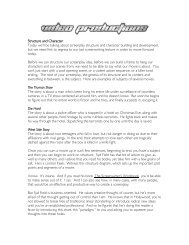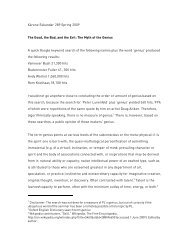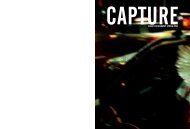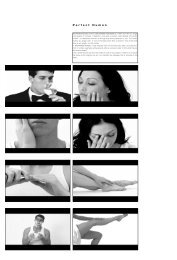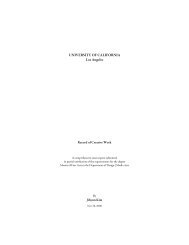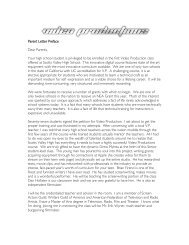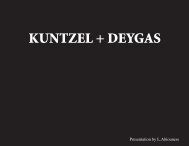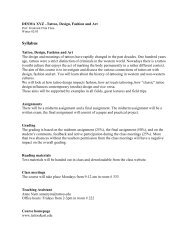Singing cells, art, science and the noise in between - Users - UCLA
Singing cells, art, science and the noise in between - Users - UCLA
Singing cells, art, science and the noise in between - Users - UCLA
You also want an ePaper? Increase the reach of your titles
YUMPU automatically turns print PDFs into web optimized ePapers that Google loves.
Both <strong>the</strong> creation of musical structures, as well as <strong>the</strong> control of a sound syn<strong>the</strong>sizer can<br />
be achieved with cellular automata-based software such as, for example, Chaosynth <strong>and</strong><br />
CAMUS, which were developed by Eduardo Reck Mir<strong>and</strong>a from <strong>the</strong> Sony Computer<br />
Science Laboratory, Paris, <strong>and</strong> collaborators. 17<br />
Indeed, <strong>the</strong> discovery of cellular audio st<strong>and</strong>s <strong>in</strong> a large musical <strong>and</strong> scientific context, <strong>in</strong><br />
which <strong>the</strong> scientific exploration of nature’s sound goes h<strong>and</strong> <strong>in</strong> h<strong>and</strong> with aes<strong>the</strong>tic<br />
experimentation <strong>and</strong> <strong>art</strong>istic reflection. Therefore, a comprehensive summary of all<br />
cultural <strong>in</strong>fluences <strong>and</strong> connections lies beyond <strong>the</strong> scope of this paper. But two projects<br />
deserve p<strong>art</strong>icular attention, as <strong>the</strong>y st<strong>and</strong> <strong>in</strong> closest relation to The dark side of <strong>the</strong> cell:<br />
Audio Microscope <strong>in</strong>stallation at Ars Electronica<br />
Artist Joe Davis <strong>and</strong> biologist Katie Egan presented <strong>the</strong> <strong>in</strong>stallation Audio Microscope at<br />
<strong>the</strong> Ars Electronica festival <strong>in</strong> 2000.<br />
“Audio Microscope allows <strong>the</strong> user to image p<strong>art</strong>icular liv<strong>in</strong>g <strong>cells</strong> while<br />
simultaneously listen<strong>in</strong>g to <strong>the</strong>ir greatly amplified - <strong>and</strong> species-specific -<br />
microacoustic signatures.” 18<br />
This project was <strong>in</strong>spired by an encounter of Egan with a “medic<strong>in</strong>e man” <strong>in</strong> <strong>the</strong><br />
Ecuadorian ra<strong>in</strong> forest, where she was conduct<strong>in</strong>g research at <strong>the</strong> time. The South<br />
American Native told her that plants s<strong>in</strong>g songs. Be<strong>in</strong>g aware of <strong>the</strong> fact that many p<strong>art</strong>s<br />
17 Evolv<strong>in</strong>g Cellular Automata Music: From Sound Syn<strong>the</strong>sis to Composition, Eduardo Reck Mir<strong>and</strong>a,<br />
http://galileo.c<strong>in</strong>com.unical.it/esg/Music/workshop/<strong>art</strong>icoli/mir<strong>and</strong>a.pdf<br />
18 Image <strong>and</strong> quote taken from <strong>the</strong> Audio Microscope page at Ars Electronica:<br />
http://www.view<strong>in</strong>gspace.com/genetics_culture/pages_genetics_culture/gc_w03/davis_audio_scope.htm<br />
21



